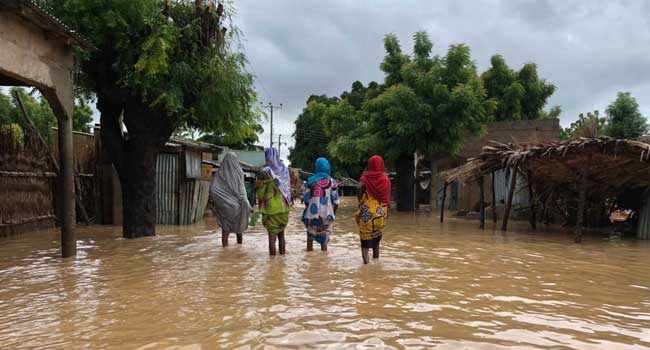 |
| A file photo of a flooded community in Jigawa State. |
The Nigeria Hydrological Services (NIHSA) has blamed sub-national governments, including state and local governments, for failing to heed "adequate and timely warnings" and weather advisories issued by various Federal Government agencies, including NIHSA and the Nigerian Meteorological Agency (NiMet), in order toto avoid a flood disaster in 2022.
"If relevant sub-nationals had heeded our predictions, we would not be where we are today," NIHSA Director General Clement Nze said on Channels Television's Sunrise breakfast show on Saturday.
He further said that earlier this year, the Minister of Water Resources, Suleiman Adamu, issued letters to state governors warning them of the impending terrible floods of 2022, but some of the governors ignored the warning.
"They (weather predictions) were out early enough to set the tone for what to expect throughout the year," Nze remarked. The Nigerian Meteorological Agency issued a forecast on February 15 to build a picture of what to expect, and my own agency, Nigeria Hydrological Services, quickly followed suit.
"The Minister of Water Resources, who unveiled the prediction, the annual flood outlook, issued warnings and letters to each state government in Nigeria, as well as relevant ministries such as agriculture, environment, and aviation, informing them of specific locations in their states to watch out for during the rainy season."
"The letters were written by him (minister), signed, and delivered to the governors; they were notified, and the requisite steps were taken."
Over 300 people have been killed, and many have been displaced...
Massive flooding has occurred in several coastal and non-coastal areas of the country in recent weeks as a result of excessive floods and input from foreign sources such as Cameroon. According to the National Emergency Management Agency, severe floods in Nigeria killed over 300 persons in 2022. (NEMA).
Hundreds of communities have been swamped in Delta, Anambra, Bayelsa, Adamawa, Taraba, Benue, Kogi, Jigawa, Kano, and Sokoto, among others, with thousands of citizens uprooted and hectares of farmlands washed away, potentially exacerbating the food situation, according to analysts.
NEMA has predicted that the 2022 flood disaster will be worse than the 2012 flood disaster, which killed at least 363 people and displaced over 2.1 million people.
However, the NIHSA director stated that the size could have been decreased if the correct steps were taken, such as demolition of constructions obstructing drainage, proper trash management, and many others.
'State governments must accept responsibility.'
Onimode Abdullahi, a NEMA Director who also spoke on the program, stated that the state administration must accept responsibility for what has occurred.
According to him, municipal planning and waste management bodies in their respective states should have acted before the flood spilled thon eir towns and relocated citizens from lowlands to higher ground and safe zones.
"At the subnational level, we needthe political will to advance this process." "It's sad that the flood occurred and that individuals had to be relocated." It is anticipated that the lessons learned would help.


